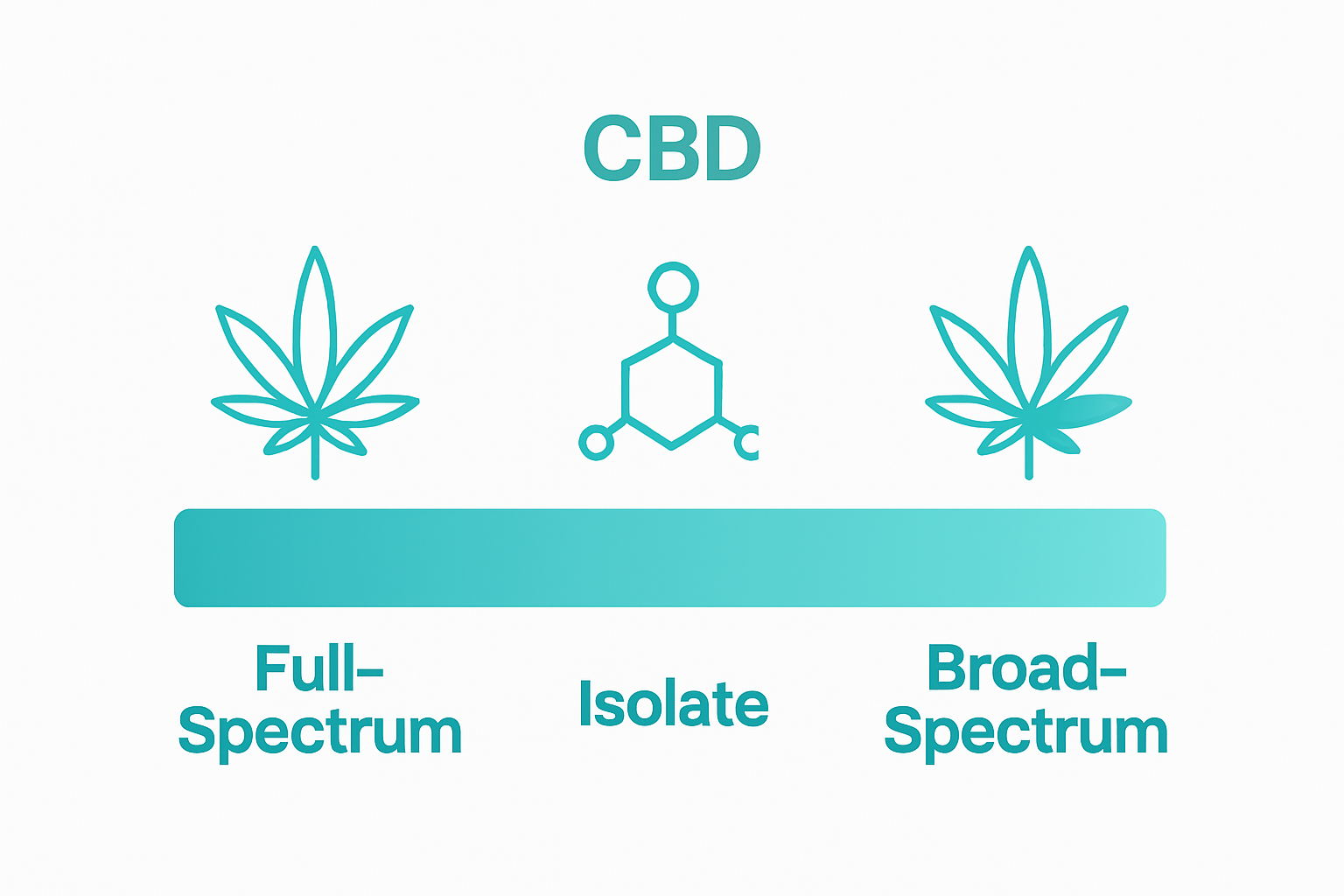

Understanding the CBD Wellness Guide for Natural Health
CBD comes from hemp and is changing the way people think about natural wellness. Here is the surprise. There are over 100 unique cannabinoids in a single cannabis plant, but most people only talk about CBD or THC. That leaves out a huge story, because the real secret is not just what CBD does but how it works with your body to support balance in totally unexpected ways.
Table of Contents
- What Is Cbd And How Is It Derived?
- Why Cbd Matters For Wellness And Health
- The Science Behind Cbd: How It Interacts With The Body
- Exploring The Benefits Of Cbd In Daily Life
- Key Concepts In Cbd: Full-Spectrum Vs. Isolate
Quick Summary
| Takeaway | Explanation |
|---|---|
| CBD is non-psychoactive | CBD provides potential therapeutic benefits without causing a “high” sensation like THC does. |
| CO2 extraction is optimal | CO2 extraction yields pure and potent CBD, ensuring high-quality product integrity. |
| CBD may aid stress and sleep | Incorporating CBD into your routine can support anxiety reduction and enhance sleep quality. |
| Understand product types | Full-spectrum, isolate, and broad-spectrum CBD offer different benefits; choose based on health needs. |
| Interactions with the body are complex | CBD influences neurotransmitter systems and immune responses, potentially aiding in overall wellness. |
What is CBD and How is it Derived?
Cannabidiol, commonly known as CBD, is a fascinating natural compound extracted from the hemp plant that has captured significant attention in wellness circles. Unlike its psychoactive cousin THC, CBD offers potential therapeutic benefits without inducing a “high” sensation. Research from the National Institutes of Health indicates that CBD is one of over 100 cannabinoids found in cannabis plants, with unique interactions in the human body’s endocannabinoid system.
The Botanical Origins of CBD
CBD is primarily derived from industrial hemp, a variety of Cannabis sativa specifically cultivated for its low THC content and high CBD concentration. The extraction process involves carefully harvesting the plant’s flowers, leaves, and stalks to obtain the valuable cannabinoid compounds. Modern extraction techniques have revolutionized how CBD is sourced, with methods like CO2 extraction ensuring a pure, high-quality product free from unnecessary contaminants.
Understanding CBD Extraction Methods
The process of obtaining CBD involves several sophisticated techniques, each with distinct advantages. Three primary extraction methods dominate the industry:
-
CO2 Extraction: Considered the gold standard, this method uses pressurized carbon dioxide to pull pure CBD from hemp plant material, producing an exceptionally clean and potent extract.
-
Ethanol Extraction: A solvent-based approach that uses high-grade alcohol to separate cannabinoids from plant matter, resulting in a full-spectrum extract rich in therapeutic compounds.
-
Oil Extraction: A traditional method where hemp is heated and combined with a carrier oil like coconut or olive oil, creating a more accessible and home-friendly extraction technique.
By understanding these extraction methods, consumers can make informed choices about the CBD products they select.
The table below summarizes different CBD extraction methods, highlighting how each process works and their related advantages based on the article content.
| Extraction Method | How It Works | Primary Advantage |
|---|---|---|
| CO2 Extraction | Uses pressurized carbon dioxide to separate CBD | Exceptionally clean, pure extract |
| Ethanol Extraction | Uses high-grade alcohol as a solvent | Produces full-spectrum extracts |
| Oil Extraction | Combines hemp with carrier oil through heating | Simple, home-friendly method |
| Check out our guide on CBD smoking to learn more about how these extraction techniques impact the final product. |
Why CBD Matters for Wellness and Health
CBD has emerged as a significant wellness compound, offering potential therapeutic benefits that extend far beyond traditional wellness approaches. Research published in the National Institutes of Health suggests that CBD plays a crucial role in modulating immune responses and managing inflammatory processes, making it a promising natural alternative for holistic health management.
The Physiological Impact of CBD
The human body contains an intricate endocannabinoid system that interacts directly with cannabinoids like CBD. This system helps regulate critical functions including mood, sleep, appetite, and stress response. By engaging with cannabinoid receptors throughout the body, CBD potentially supports internal balance and homeostasis, offering a natural approach to wellness that works with the body’s existing regulatory mechanisms.
Potential Wellness Applications
CBD’s versatility in wellness practices is remarkable, with potential benefits spanning multiple health domains:
-
Stress Management: CBD may help reduce anxiety and promote relaxation by interacting with neurotransmitter systems
-
Sleep Support: Preliminary studies suggest CBD could improve sleep quality and help regulate sleep cycles
-
Inflammation Reduction: CBD shows promise in potentially mitigating chronic inflammation, a root cause of many health challenges
While research continues to evolve, many individuals are exploring alternative wellness approaches with CBD smoking as part of their holistic health strategy. Understanding these potential benefits empowers individuals to make informed decisions about incorporating CBD into their wellness routine.
The Science Behind CBD: How It Interacts with the Body
Research from the National Center for Biotechnology Information reveals that CBD operates through a complex interaction with the human body’s endocannabinoid system, distinguishing itself from other cannabinoids by its non-intoxicating properties. This sophisticated molecular communication occurs through specialized receptors distributed throughout our nervous and immune systems, enabling potential therapeutic interventions without producing psychoactive effects.
The Endocannabinoid System Explained
The human body contains an intricate network of cannabinoid receptors, primarily CB1 and CB2, which form the foundation of the endocannabinoid system. Unlike THC, which directly binds to these receptors, CBD acts as a subtle modulator, influencing neurotransmitter release and cellular communication. This unique mechanism allows CBD to potentially regulate various physiological processes without causing significant disruption to normal bodily functions.
Molecular Interactions and Potential Benefits
CBD’s interaction with the body involves multiple sophisticated pathways that contribute to its potential wellness properties:
-
Neurotransmitter Regulation: CBD may help balance serotonin and dopamine levels, potentially supporting mood stabilization
-
Inflammatory Response: By interacting with immune system receptors, CBD could help modulate inflammatory processes
-
Stress Response: CBD might influence the hypothalamic-pituitary-adrenal axis, potentially reducing stress-related physiological reactions
These complex interactions demonstrate why many individuals are exploring natural relaxation techniques with CBD. Understanding these scientific mechanisms provides insight into how CBD might contribute to holistic wellness strategies.
Exploring the Benefits of CBD in Daily Life
Research published in the National Institutes of Health demonstrates that CBD offers potential wellness benefits that can be seamlessly integrated into daily routines. Beyond its therapeutic potential, CBD represents a holistic approach to managing modern lifestyle challenges, providing natural support for various aspects of personal well-being.
CBD for Mental Wellness and Stress Management
In an era characterized by constant connectivity and heightened stress levels, CBD emerges as a potential natural ally for mental equilibrium. By interacting with neurotransmitter systems, CBD may help individuals manage anxiety, promote emotional balance, and support cognitive resilience. This subtle yet powerful interaction offers a complementary approach to traditional stress management techniques, helping individuals navigate complex emotional landscapes with greater ease.
Practical Applications in Daily Wellness
CBD’s versatility allows for numerous practical applications across different lifestyle domains:
-
Morning Routine Enhancement: Supporting mental clarity and reducing morning anxiety
-
Physical Recovery: Potentially assisting with post-exercise muscle relaxation and reducing inflammation
-
Evening Relaxation: Promoting better sleep quality and supporting natural circadian rhythms
Those interested in exploring personalized wellness strategies might want to discover the best CBD strains for natural wellness to align with individual health objectives. Understanding these diverse applications empowers individuals to make informed decisions about incorporating CBD into their personal wellness framework.

Key Concepts in CBD: Full-Spectrum vs. Isolate
Scientific research from the National Center for Biotechnology Information highlights the critical differences between full-spectrum and isolated CBD products, revealing nuanced approaches to cannabinoid consumption. Understanding these variations allows consumers to make informed decisions about their wellness strategies, recognizing that each type of CBD product offers unique potential benefits.
Understanding Full-Spectrum CBD
Full-spectrum CBD contains a comprehensive range of cannabinoids, terpenes, and plant compounds naturally found in hemp. This approach embraces the concept of the ‘entourage effect,’ where multiple cannabis compounds work synergistically to potentially enhance therapeutic outcomes. Unlike isolated CBD, full-spectrum products maintain the plant’s original chemical composition, preserving a complex network of potentially beneficial molecules that interact with the human endocannabinoid system.
Comparing Full-Spectrum and Isolate Characteristics
Each CBD product type offers distinct advantages for wellness seekers:

-
Full-Spectrum CBD: Includes multiple cannabinoids and plant compounds, potentially offering broader therapeutic potential
-
CBD Isolate: Pure cannabidiol without additional compounds, providing a targeted and controlled CBD experience
-
Broad-Spectrum CBD: A middle ground containing multiple cannabinoids but without trace amounts of THC
Those curious about exploring different hemp varieties might want to learn more about understanding hemp strain differences. Selecting the right CBD product depends on individual wellness goals, sensitivity, and desired effects.
To clarify the differences between the major CBD extract types, the table below compares full-spectrum, isolate, and broad-spectrum CBD based on their composition and typical use cases.
| Type of CBD | Key Components | THC Content | Common Use Cases |
|---|---|---|---|
| Full-Spectrum CBD | Multiple cannabinoids, terpenes, plant compounds | May contain trace | Broader wellness support, |
| amounts (<0.3%) | potential ‘entourage effect’ | ||
| CBD Isolate | Pure cannabidiol (CBD) only | None | Controlled dosage, sensitive users |
| Broad-Spectrum CBD | Multiple cannabinoids/terpenes, no THC | None | THC-free alternative, synergistic effects |
Discover a Natural Path to Wellness with Full Moons Club
If you have been searching for a healthier alternative to tobacco, longing to align your daily habits with the natural benefits of CBD explored in this guide, you are not alone. Many readers share your frustration with traditional cigarettes and the uncertainty of chemical-laden alternatives. Full Moons Club understands these challenges and offers a genuine solution for those seeking balance, relaxation, and a mindful approach to wellness. Our products embrace key scientific concepts from the article, including high-quality full-spectrum hemp, organic CBD, and a tobacco-free, nicotine-free experience.

Ready to move beyond uncertainty and embrace a cleaner lifestyle? Explore our CBD Cigarettes, Lighters & Totes for Sale for a curated collection crafted from potent cannabinoids like CBD, CBG, and CBC, while ensuring you stay 0% THC compliant. Choose the sustainable option that fits your holistic health journey and see the difference quality makes. Visit Full Moons Club today for fast shipping and a smoother, chemical-free smoking alternative. Your path to natural wellness starts here. See all wellness-focused products and enjoy the healthier way to unwind.
Frequently Asked Questions
What is CBD and how is it derived?
CBD, or cannabidiol, is a natural compound extracted from the hemp plant, specifically from industrial hemp cultivated for its low THC content and high CBD concentration. The extraction involves harvesting the plant’s flowers, leaves, and stalks, often using advanced methods like CO2 extraction to ensure a pure and high-quality product.
What are the different extraction methods for CBD?
The primary extraction methods for CBD include CO2 extraction, which uses pressurized carbon dioxide to create a clean extract; ethanol extraction, using high-grade alcohol to separate cannabinoids; and oil extraction, which combines hemp with a carrier oil like coconut or olive oil. Each method has its unique advantages.
How does CBD interact with the body’s endocannabinoid system?
CBD interacts with the body’s endocannabinoid system through specialized receptors, mainly CB1 and CB2, modulating neurotransmitter release and influencing various physiological processes without inducing psychoactive effects. This interaction helps regulate functions like mood, sleep, and stress response.
What are the benefits of using full-spectrum CBD compared to CBD isolate?
Full-spectrum CBD includes multiple cannabinoids and plant compounds, potentially offering a broader therapeutic effect known as the ‘entourage effect.’ In contrast, CBD isolate is pure cannabidiol, providing a more targeted experience without other compounds. The choice between them depends on individual wellness goals and desired effects.

